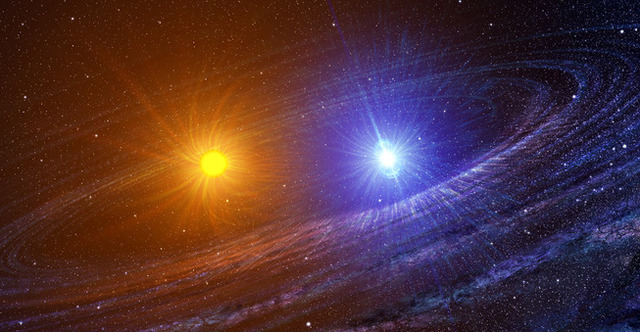When you think of a nova explosion, you probably associate it with a supernova—a similar, but fundamentally different, stellar explosion. The word nova is Latin for “new,” referring to what early astronomers thought was a bright new star in the sky (specifically, Tycho Brahe in 1573 with his book De nova stella). We now know the general mechanism behind a nova—it’s a runaway nuclear reaction—but there is (at least) one mystery that’s confounded astronomers for almost 50 years.
The nuclear reactions propelling the nova produce isotopes of carbon, nitrogen, and oxygen (among others), in addition to the primary product of hydrogen fusion, helium. But even though the process should be spatially even, these species don’t end up spatially homogenous. For example, in observations of the nova V1974 Cygni, there’s three times as much carbon in one position compared to another in the nova’s shell. Physical modeling hasn’t been able to account for this difference. A team of researchers from Spain, Italy, and the US tackled this problem and found that the source of this difference is actually a common fluid dynamics phenomenon.
There’s often some confusion about the difference between a nova and a supernova. A nova is a runaway nuclear explosion that results from the accretion of hydrogen on the surface of a white dwarf. This star must have a companion (the two form a binary system) from which to draw off the hydrogen. Only a small portion of the star’s mass is consumed in a nova, so many (if not all) nova recur, although the period of time can range from decades to millennia.
A supernova, on the other hand, is a destructive, extremely bright explosion caused by the star gravitationally collapsing in on itself (there are a couple different ways this happens). Most of a star’s mass is ejected in a supernova, so this can happen only once.
So how does a nova, which should start with relatively well-mixed materials, produce an asymmetric explosion? In order to explain this discrepancy, we need to understand the physical processes that occur during the explosion. It has been suggested that thermonuclear reactions may be producing greater quantities of certain species. But these reactions are well known and the temperatures of novas we’ve observed don’t make sense with this theory.
The other main possibility is mixing at the core/shell interface, but one- and two-dimensional computational simulations haven’t been able to see this. The team behind the new research performed three-dimensional simulations of a nova explosion and focused on mixing at the core/shell interface. They found that shear flow at the interface triggers Kelvin-Helmholtz (KH) instabilities—which in turn cause the mixing. Previous studies only used one- and two-dimensional simulations, which couldn’t capture the three-dimensional nature of the complex vortex structures created.
The KH instability is a well-known fluid dynamics phenomenon (first described by Lord Kelvin in 1871 and Hermann von Helmholtz in 1868) caused by a significant velocity difference between two fluids. Basically, the faster-moving fluid pulls the other into motion, and this interaction develops swirling waves that eventually transition into full-blown turbulent mixing. This occurs frequently in nature, in clouds, the ocean, Saturn’s atmosphere—and apparently also in novae.
The three-dimensional nature of turbulence is well-known to the fluid dynamics community, so it’s not clear why this appears to be the first simulation of a nova explosion in 3D. However, the team did solve this decades-old mystery, which should help improve our understanding of not only this fascinating stellar phenomenon, but also one of the sources of heavier elements in the universe.
Source:
Decades-old mystery solved as researchers reveal how stellar novae get all mixed up
Ars Technica, October 27, 2011



What's been said:
Discussions found on the web: